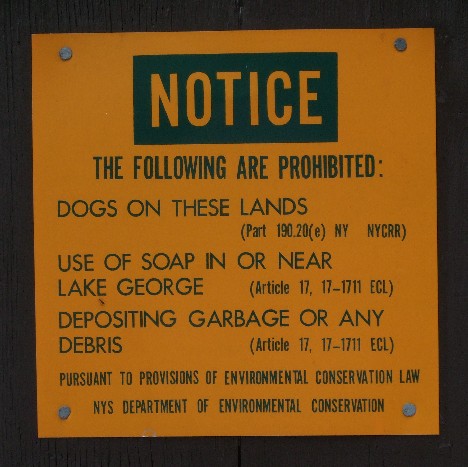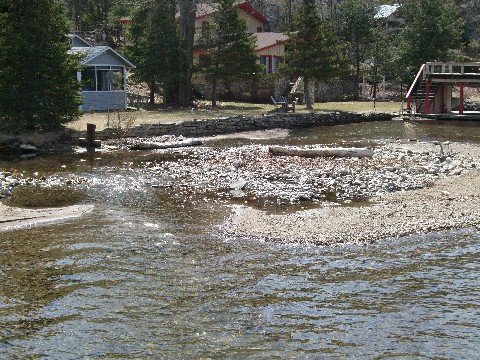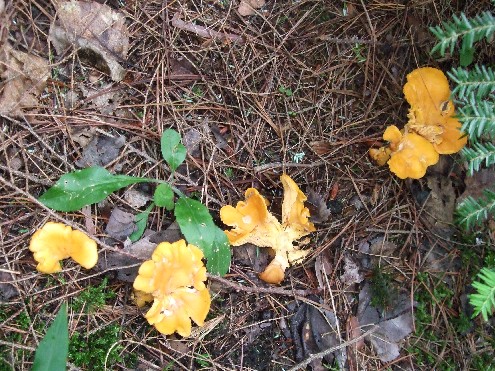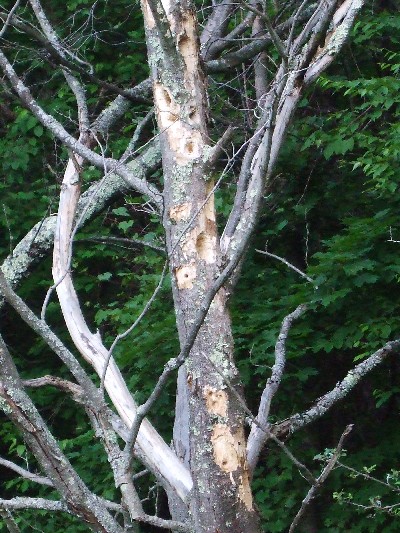
Seen on Narrow Island

News & Opinion About Huletts Landing, N.Y.

Seen on Narrow Island
A Bad Harvest?
The Post Star recently had an article about Dresden Town Board member, John Barber, and his apple orchard. It discusses the problems he has had with bad weather this year. (John’s seat on the Town Board is not up for election this year.)
Coast Guard Proposes New Rules for Ballast Water
The Washington Post writes about proposed new Coast Guard standards for ballast water treatment that had been long awaited by people concerned about the impact of invasive aquatic species transported via ballast water in ships. This would apply to ships passing through the canal that runs through Whitehall.

This was recently forwarded to me. It’s a rattlesnake with its tail tagged and painted red by the DEC.
It was spotted near the dock for sites 3 & 4 on “Floating Battery” island, which is part of the Mother Bunch Group.
The DEC spotted it, and went to warn the campers. Unfortunately, the two campsites had tents, but the campers were not around to let them know the snake was visiting.
The DEC marks rattlesnakes they find for someone who does a study on them. This is a particularly big one. It’s probably at least 5 feet long and wide as a soda can in the middle! Makes you want to rent a house next summer!
If you’ve never heard a rattlesnake, it makes a sound almost exactly like a baby’s rattle. I heard one once but never saw it.
Now we’ve all seen a particularly big one!
Post Star Editorial on Making the APA Pay
Sound familiar?
“The agency’s staffers can read. They knew they were twisting the law beyond any legitimate shape, but they pushed ahead anyway, in bad faith.”
It’s not just happening in Huletts. The APA is taking unjustified positions in other areas also. For this they’ll most likely pay. Literally. Read the Post Star editorial here.
How Do You Spend You Day?
The NY Times has this neat interactive graphic which shows how different groups of people spend their day. Cool.
You can read the Post Star’s article on Foster Brook here.
Here’s the bottom line.
The APA’s involvement:
nearly prevented the project from happening.
added approximately $5,000 or more to the cost.
results in 100 to 150 dump truck trips of 20 miles each, instead of 1/2 mile each.
cost everyone time, energy and aggravation.
didn’t do anything to help the environment.
I just got off the phone with the Post Star reporter who will be doing a story over the weekend about the whole Foster Brook saga. The reporter told me that the APA spokesman who they interviewed made the assertion that the APA went out of their way to accommodate us.
As the landowner of where the dredged material was going to be put, I can say that is completely untrue.
They weren’t cooperative on their site visit when they alleged the material was waste and both the LGA representative and I argued with them on the spot.
They weren’t cooperative when the DEC told them their interpretation was wrong and in conflict with theirs.
They weren’t cooperative when I wrote to them on August 18th and told them that if they continued their interpretation; “we doubt we would be able to file this permit and/or allow our property to be used for accepting the dredged materials.”
They weren’t cooperative when we asked to see a draft permit leading up to Labor Day so we could update the community on what was happening. They waited until Tuesday, September 8th, after everyone had left for the weekend.
They certainly weren’t cooperative when they issued the draft permit, which attempted to declared our property a “waste disposal area” and place other ridiculous conditions upon us. (Don’t be surprised by this, but they weren’t cooperative with the Post Star reporter either, refusing to release the draft permit to him, but don’t worry I did.)
If you want to know the truth, they weren’t cooperative at all. They hoped that by springing a permit on us at the last moment which we told them we wouldn’t accept, and which the DEC told them was wrong, they would blow up the deal entirely for at least another year and maybe permanently. They didn’t expect that the LGA would find another location to accept the materials. That’s the truth.
No where in this whole saga did they care about the environment.
They certainly didn’t care about the tiny smelts who can’t run up the stream anymore because they’re being blocked by the delta.
They didn’t care about 100 dump trucks going over the mountain to a site 10 miles away as opposed to our site less than a mile away.
The only thing they cared about was their extreme anti-people agenda which we just told you about. This is a perfect example of why a high level state official told me these radical environmentalists, “have no credibility left with anyone”.

I am happy to report that I just spoke to the Lake George Association and the Foster Brook project is on again. The Town of Dresden will be accepting the dredged materials and while this will add additional cost to the project, the project will be starting within days. No one sees any need for the Adirondack Park Agency to be involved.
The DEC should be amending the dredging permit and any delayed work will get done.
While I will be working on a more complete report in the days ahead, there are some heroes and villains in this story.
Many thanks go out to all of you for contacting the Governor’s office. It did help. Secondly both the Lake George Association and the Town of Dresden deserve worthy praise for their efforts to see this project through. The Town of Dresden understood what was happening and quickly stepped up to the plate. Finally, the DEC understood the importance of this project and was cooperative throughout.
To those sad people at the Adirondack Park Agency, who claim they are “environmentalists” but are nothing more than people unfriendly-elitists, shame on you. You know where you can shove your definition of “waste”. I was told by one official that these so called “environmentalists” “have no credibility left with anyone”. You can expect some eye-opening stories about the hypocrisy of many in this crowd over the next few months.
I’ll have another update soon.

Do You See Waste or Gravel?
Sadly, I have to report that the Adirondack Park Agency has thwarted the removal of the clogged mouth of Foster Brook. The Adirondack Park Agency is sticking to an interpretation that is in conflict with the Department of Environmental Conservation and common sense. While the DEC has issued the permits to start dredging, there is no place to put the dredged material. As one of the owners of the parcel where the material was going to be put, I wanted to tell you first hand what is transpiring and why we have had to pull out of the project.
I was informed by the Lake George Association in the middle of the summer that the DEC had issued the permit to dredge Foster Brook. I posted that news here.
We have always wanted this project to proceed and, in this regard, we offered to allow the dredged material to be put in our gravel pit to save the LGA money. If they couldn’t use our pit, the LGA was looking at a substantial cost increase in moving the material over the mountain. They approached the APA and asked if a permit was necessary for the dredged material to be put in our gravel pit.
The APA conducted an on-site inspection during late July/early August. The APA sent two staff members to see the site where the material was going to be placed. During that meeting, one staff member asserted that a permit would be needed because the dredged material, being removed from Foster Brook, was “waste”. We later learned that he was instructed to make this interpretation by a supervisor.
Both the LGA representative and myself thought this interpretation was wrong. The DEC had previously tested the material and found it to be “clean fill”. We went ahead and applied for the permit in good faith, but I also wrote a letter to the APA which clearly indicated we did not accept their terminology and we did not consent to it being called “waste”. I said, in no uncertain terms, if the APA wanted to continue calling the material waste, we could not go ahead and let our property be used to place the dredged material.
I copied this letter to the DEC and the Governor’s office because both the APA and the DEC are executive agencies of the Governor’s office. On August 21st, the DEC called and told me our interpretation was correct and that the APA was in error to call the material “waste”. The DEC official was quite clear that, if gravel was defined as “waste”, almost every driveway throughout the Adirondacks would now have “waste” on it. The DEC official further told me that it was the DEC’s position that an APA permit wasn’t needed in order to put the dredged material in our gravel pit.
We repeatedly asked to see a draft permit from the APA during the week leading up to Labor Day. Only today did we receive a draft permit which attempts to assert jurisdiction under Section 810(d)(16) which applys to waste disposal areas. In addition, the draft permit tries to assert other conditions which we cannot agree to. In my opinion, this has been deliberately done, by some radical environmentalists at the APA, with the knowledge that we would not accept these conditions and that the project would not proceed. The most radical elements of the environmental movement see this delta as a wetland being created and do not care that private property is being impacted by flooding. Also remember that the DEC permit requires that the dredging be done by Ocrober 1st, so any delay is a full fledged effort to stop this project from going forward.
I am very disappointed that, after numerous years of work by many people, our good faith offer to allow the material to be put in our gravel pit has been met by one of the most outlandish interpretations ever made by the APA.
An interpretation such as this, which contradicts another state agency, has most likely been made in the Governor’s office. Either the Governor has specifically allowed this interpretation to be made or he is simply allowing the Adirondack Park Agency to run his administration. If you would like to call or email the Governor’s office directly you can contact him here. You can ask to speak to his secretary, Mr. Lawrence Schwartz.
Unless the Governor intervenes and corrects this interpretation or another site can be found to put the dredged material, the Foster Brook dredging will not take place this year.
With the end of the summer, comes the end of thunderstorm season. The first two minutes of this video show the Perpetuum Jazzile of Africa performing the sounds of a thunderstorm. (Be sure to turn you speakers up for the beginning.) Wow!
httpv://www.youtube.com/watch?v=yjbpwlqp5Qw
.. in a supermarket for wild mushrooms like this.

I found these as I was hiking through the woods. This illustrates how wet it has been this summer.

Seen on top of the mountain.
Good Samaritans Help Survivors of Dresden Car Wreck

The Post Star reports here on a bad car crash that took place on Route 22 in Dresden. I spoke to some at the scene and from what I can gather, it was quite a bad wreck. A helicopter was brought in to air-lift the survivors out. Everyone who stopped and helped should be commended.
Lake George Park Commission Delays Stream Action Another Month
The LGPC issued this press release recently.
With the clear August nights we’ve been having, I thought this video on how to find the “Big Dipper” and the North Star would be interesting.
You can spot the “Big Dipper” at this time of the year from Huletts, by looking across the lake in the evening between Deer’s Leap and Sabbath Day Point. This video gives some background info and how to find the North Star once you’ve located the Big Dipper.
httpv://www.youtube.com/watch?v=hepzUgFhgis
Governor Seeking to Streamline Bureaucracy
This Denton Publications article talks about the Governor’s attempt to curb unnecessary regulations.
Washington County Revenue Falls
The Post Star reports that Washington County’s revenue is projected to decline.